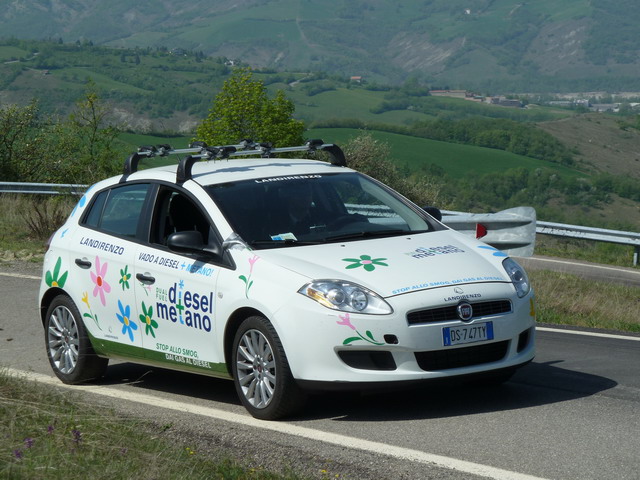|

The latest Legambiente (an environmentalist
group) report, regarding what we breathe in the cities,
states that the quality of the air remains terrible.
To blame are the fine particles that are the cause of
more than 15 premature deaths every 10,000 inhabitants and
of extensive economic damage. The sanctions worth billions,
placed by the European Commission for lack of respect of the
regulatory limits, are summed to the 28 billion euros/annum
in costs for mortality, diseases and years of life lost
estimated by the World Health Organization. A severe human
and economic damage that has among its principal causes, the
transport sector, especially that of the gas oil vehicles
which lacks the diesel particulate filter. In Italy, these
are close to 10 million.
How to solve the problem? Renew the car
fleet, difficult in times of crisis, or apply the retrofit,
costly and still of dubious efficiency, to the cars which
lack the diesel particulate filter (DPF). A third option
could arrive by year’s end: the conversion to natural gas of
the diesel engines. Landi Renzo is experimenting the Dual
Fuel kit which, compared to the bi-fuel systems for petrol
engines where the feeding
comes about with one of the two fuels, functions with a mix
of gas oil and natural gas. An obligation, seeing that, in
the absence of the ignition system, the striking of burning
necessitates the gas oil. An ingenious idea that we tested
on the roads of the Reggiano area at the wheel of a 2008 120
hp Fiat Bravo 1.9 MJT, without DPF and with Euro 4
anti-pollution homologation.
The passenger compartment is that of the
second series of the compact Fiat in its Dynamic
arrangement, with the addition of a tangle of cables and a
switch on the dashboard at the bottom of the console a panel
with different switches and a digital display: we are on
board of a car laboratory. A micro computer that signals
possible faults to the system, bears the average consumption
of natural gas and gas oil, the residual range with the two
fuels and allows to select the feeding mode (dual or
normal); in its final version it will be substituted by the
classical gas level switch/indicator of the fuel kits.
In the engine compartment the components of
the system and even the
adaptor for the natural gas supply. In the boot, the
original 400 litre capacity is more than halved by the 14.63
litre tank of natural gas. On ignition the presence of the
double feeding is perceived solely by the messages on the
display which activate the system and at the written
“Dual-fuel modality” that appears once the set parameters of
the engine have been reached. At its minimum, the 4
cylinders of the Bravo runs only by gas oil and a growing
percentage of CNG (from 20 to 60%) is activated starting
from the 1,500 revs/minute only to come out once the 3,000
revs have been exceeded. A progression that allows for a
high reliability and leaves unaltered both the original
loads and performance. While driving, the “conversion is not
perceivable, not even by ear”.
The Dual Fuel Bravo maintains both the
qualities and faults of the 1.9 MJT unaltered, such as a
certain laziness to pick up under the 1,500 revs/minute, a
mark above which it has an excellent progression up to the
3,500 revs. No coincidence, nearly exactly the same range
of action of the Landi Renzo kits that, therefore,
functions in all the situations of normal driving (at 130
km/h, for example, it travels at slightly above the 2,500
revs), with the exception of the minimum and the sporty
driving.
The advantages are noteworthy. The principal
one is the average decrease by 60% of the release of the
fine particulates, a percentage that increases for the
pre-Euro 4 models. All this, while leaving the emissions of
the other pollutants unaltered, such as carbon monoxide and
nitrogen oxide, and a slight increase of the unburned
hydrocarbons. This should ensure the Dual Fuel system to
gain the vehicle to which a Euro class of the
anti-pollutant European regulation will be applied.
Environmental benefits are obtained thanks also to the
average drop of the CO2
emissions (from 139 to 118 grams/km). The
range increases, from the initial 1,094km to the 1,431 of
the “double” full tank, with a supplement of 337km supplied
by natural gas.
The conversion brings good news even to the
personal finances thanks to an average saving of 15-18% on
the costs: the distance covered on a litre of gas oil
increases from 18.87 to 31.45 km, data to which one must add
a consumption of 1.9 kg every 100 km on natural gas.
Therefore, with the mixture, the cost per kilometre
drops from 7.7 to 6.3 euro cents: during the life span of
the vehicle this can compensate the almost 2,000€ of the
transformation. According to our calculations, the
break-even point today is at approximately 140,000 km, an
amount destined to be reduced due to the fact that the cost
of the gas oil increases in a more sudden manner than that
of natural gas.
But, all the advantages could increase: the
Bravo of the test drive is only the first step of the
evolution anticipated by Landi Renzo. Once the desired
reliability has been obtained and the system has been
homologated, the technicians from Cavriago intend to perfect
the system by extending the operating mode and increasing
the percentage of natural gas injected by 80%. Improvements
which can be benefited from by the owners of the first
versions of the Dual Fuel with the updating of the software
during the normal maintenance coupons.
Stefano Panzeri
I read and...
:
|
